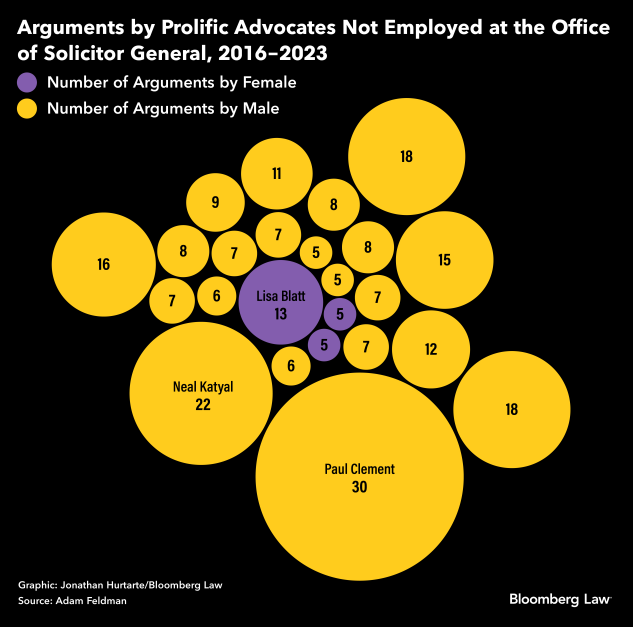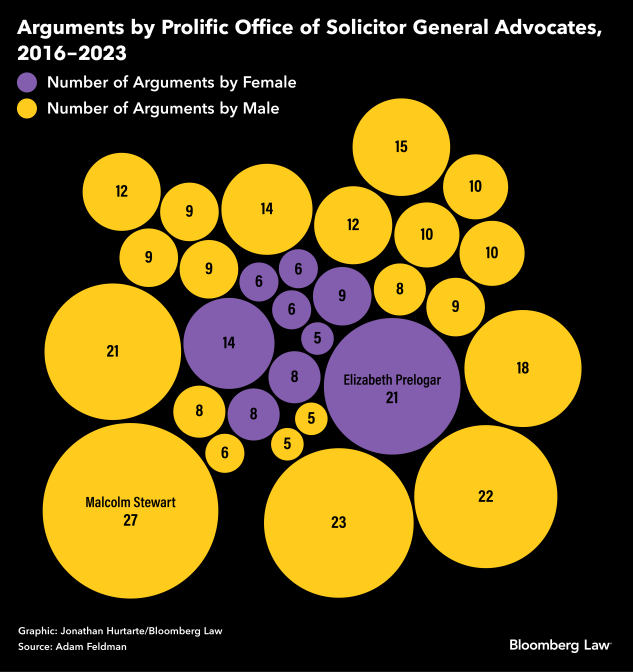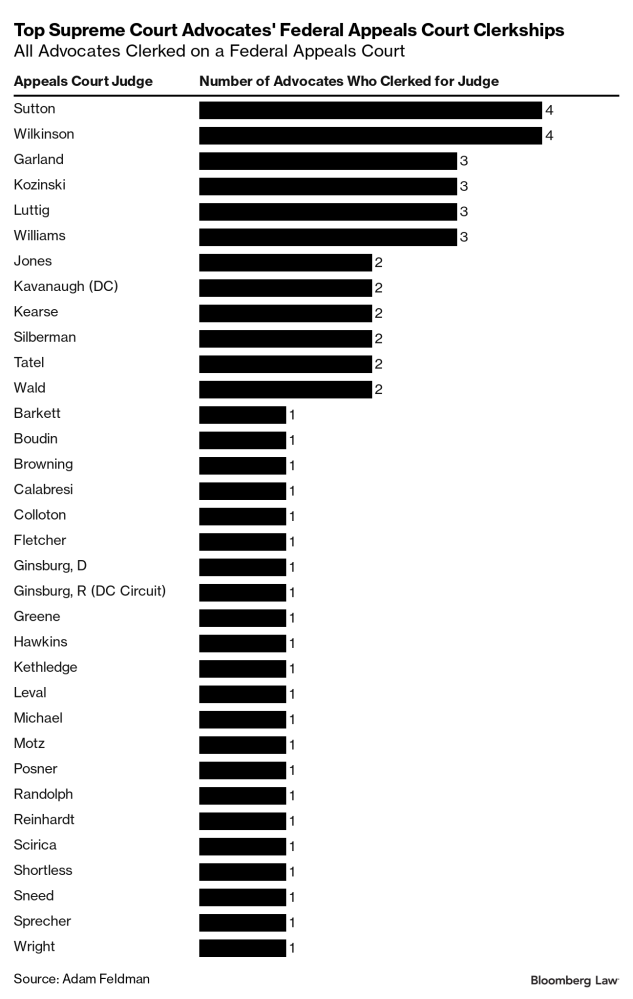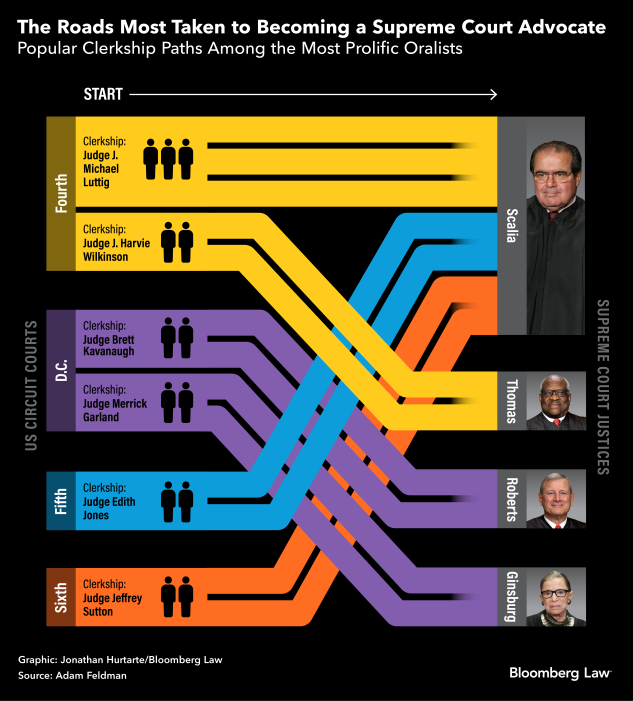Empirical SCOTUS’s Adam Feldman analyzes data to show the paths most taken and the traits most favorable to becoming one of the few attorneys who argue frequently at the US Supreme Court.
Very few attorneys have a chance to argue before the US Supreme Court. In part, this is because the justices only take about 1% of the petitions filed with the court, but it’s also because the same attorneys argue before the court again and again.
Some of the justices have spoken in support of this shallow pool of advocates. In 2002, Judge John Roberts—then of the US Circuit Court of Appeals for the District of Columbia—said, “Obviously better advocacy—if in fact that is what comes with more experienced advocates—is a good thing. A well-argued case will not necessarily be well decided; sometimes the judges get in the way. But there is a significant risk that a poorly argued case will be poorly decided.”
This small club of attorneys has been well-documented, but the characteristics of its members are somewhat opaque. To dive into an analysis of common characteristics of top attorneys before the Supreme Court, I used a list of the 55 attorneys who argued there the most between October 2016 and December 2023.
There is significant homogeneity among this group, with the most common profile a male who graduated with a law degree from Harvard, Yale, or Stanford and who clerked at a federal appeals court and then the Supreme Court. There are a couple of especially well-worn paths from law school to this club as well. Let’s break it down.
Gender
The top Supreme Court advocates by appearances are mostly male. However, women fare much better if they work in the Office of the Solicitor General—which advocates for the federal government before the high court—than if they’re in private practice. Of the private practice attorneys on the list, only three are female.
The only private-side female attorney with more than five arguments is Williams & Connolly’s Lisa Blatt, who argued 13 cases during this period.
Of the OSG attorneys in this group, nine are female. Current Solicitor General Elizabeth Prelogar leads the way for women with 21 arguments. Prelogar is still several shy of Malcolm Stewart’s 27 arguments for this period, but Stewart has had a longer tenure there.
Law School
Going to a top law school is an almost-necessity but not a sufficient criterion to reach this hallowed position in appellate advocacy. This barrier to entry alone shrinks the pool of potential advocates considerably. Here is the breakdown of law schools for the top 55 advocates.
All the law schools on this list are highly ranked. The top two schools, Harvard and Yale Law, account for graduating almost 50% of the advocates covered. If you add in the advocates from Stanford, then you have well more than 50% of the advocates.
Clerkships
We’ve now narrowed Supreme Court repeat players to mainly men who attended top-tier law schools. There are also specific lower-court and Supreme Court clerkships that top advocates share.
Each of the advocates in the top 55 clerked at the federal appeals court level. Below is a breakdown of lower-court judges who hired these attorneys as clerks.
Some judges have hired multiple clerks who later became Supreme Court repeat players. Judge J. Harvie Wilkinson III from the Fourth Circuit and Jeffrey Sutton from the Sixth Circuit are especially prominent in this list, each previously hiring four of the top 55 repeat player attorneys.
Supreme Court clerkships matter as well. A supermajority of the 55 attorneys clerked for a Supreme Court justice and four attorneys actually clerked for two justices each.
Far more of these attorneys clerked for Justice Antonin Scalia than for any of the other justices, including the advocate who argued the most cases on this list—Paul Clement with 30.
Certain lower-court judges whose clerks often go on to Supreme Court clerkships are known as feeder judges. These feeder judges sometimes create feeder relationships where clerks for certain lower court judges go on to clerk for the same Supreme Court justices.
There were six such feeder relationships in this list with more than one attorney following such a path. Three attorneys clerked for Fourth Circuit Judge J. Michael Luttig and went on to clerk for Scalia.
Two attorneys each clerked for Wilkinson and then Justice Clarence Thomas, Sutton, then Scalia; D.C. Circuit Judge (now Justice) Brett Kavanaugh, then Roberts; Fifth Circuit Judge Edith Jones and then Scalia and D.C. Circuit Judge Merrick Garland, then Justice Ruth Bader Ginsburg.
Generational Patterns
When we zoom out and look at all the attorneys in the top 55 list based on when they graduated from law school, we see that there’s a 41-year difference between the earliest graduation—that of Edwin Kneedler in 1974—and the latest graduation, that of Nicole Reaves in 2015. Kneedler is the current attorney with the most appearances before the Supreme Court—at 149 arguments, he far outpaces all other current attorneys on this list.
With these attorneys, we see certain well-worn paths to multiple arguments before the Supreme Court. These paths become more like ruts over the decades, as argument opportunities seem to beget more argument opportunities.
The proxies for strong advocacy include being a man who clerked at the Supreme Court and who went to Harvard, Yale, or Stanford law schools. Starting from this small pool, many worthy and qualified advocates are surely overlooked. As law firms and the government see these patterns, perhaps they will be motivated to look for qualified advocates with varied resumes.
This article has been updated to reflect Lisa Blatt’s current employer, the most recent law school graduate among the sample, and to clarify in the graphic, “Arguments by Prolific Office of Solicitor General Advocates,” that Elizabeth Prelogar argued 21 times in the time period.
This article does not necessarily reflect the opinion of Bloomberg Industry Group, Inc., the publisher of Bloomberg Law and Bloomberg Tax, or its owners.
Author Information
Adam Feldman runs the blog Empirical SCOTUS and teaches political science at California State University Northridge.
Write for Us: Author Guidelines
To contact the editors responsible for this story:
Learn more about Bloomberg Law or Log In to keep reading:
See Breaking News in Context
Bloomberg Law provides trusted coverage of current events enhanced with legal analysis.
Already a subscriber?
Log in to keep reading or access research tools and resources.






